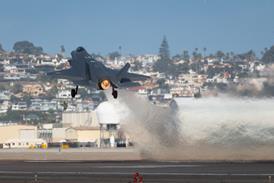Following the publication of the Brazilian final report into the 2006 fatal mid-air collision between an Embraer Legacy 600 business jet and a Gol Transportes Aéreos Boeing 737-800 over the Amazon, investigation participant the US National Transportation Safety Board says the accident was the result of "numerous individual and institutional ATC factors". Crucially, it has not been established how the Legacy's transponder had been inadvertently deactivated, preventing the airborne collision avoidance system from working.
All 154 passengers and crew on board Gol flight 1907 died in the 29 September 2006 collision after the damaged aircraft plunged to the forest floor from 37,000ft (11,285m). The Legacy (N600XL), being flown on a delivery flight by US air taxi operator Excelaire, made an emergency landing with damage to its left winglet and left horizontal stabiliser.
Brazil's investigation agency Cenipa, which headed the investigation, published its final report last week.
"The evidence collected during this investigation strongly supports the conclusion that this accident was caused by N600XL and Gol 1907 following ATC clearances, which directed them to operate in opposite directions on the same airway at the same altitude, resulting in a midair collision," says the NTSB in comments appended to the Cenipa report.
"The loss of effective air traffic control was not the result of a single error, but of a combination of numerous individual and institutional ATC factors that reflected systemic shortcomings in emphasis on positive air traffic control concepts."
As for the transponder issue on the Legacy, the NTSB says that "contributing to the accident was the undetected loss of functionality of the airborne collision avoidance system technology as a result of the inadvertent inactivation of the transponder on board N600XL. Further contributing to the accident was inadequate communication between ATC and the N600XL flightcrew."
In May 2007 the NTSB raised concerns over inadvertent deactivation of collision avoidance systems, asking the US Federal Aviation Administration to recommend that an audio warning and enhanced visual alert be introduced. This was followed by a warning to Embraer ERJ and Legacy operators that they could accidentally deactivate the type's transponder by placing their feet on the footrests directly below the instrument panel.
The NTSB in its report comments says that during "flightdeck observations conducted by the NTSB and FAA, it was observed that pilots might misuse the footrests [which could lead to] unintended contact [with the transponder]."
It adds: "It can not be determined exactly how the accident crew commanded the transponder to standby, but the possibility of an unexpected use of the footrest guard, along with other possibilities discussed in the report, serve as important reminders of human ergonomic considerations at preventing inadvertent contacts in actual flying situations," says the NTSB.
The NTSB says the investigation "has identified many safety issues for ATC operations, but these issues need to be further highlighted. Even though the body of the [Cenipa] report acknowledges safety deficiencies with ATC, these deficiencies are not sufficiently supported with analysis or reflected in the conclusions or cause of the accident."
The board adds: "These deficiencies include a lack of timely ATC action after the loss of N600XL's transponder and two-way radio communication, and features of the ATC software that may have aggravated deficiencies in altitude clearance awareness for N600XL,."
Source: Flight International























